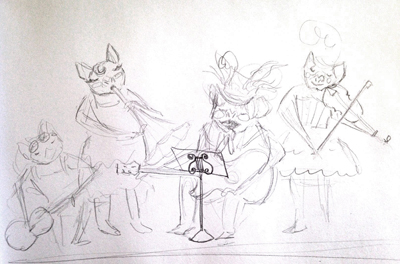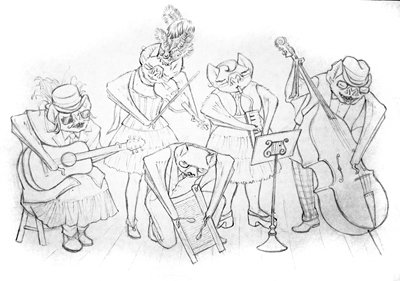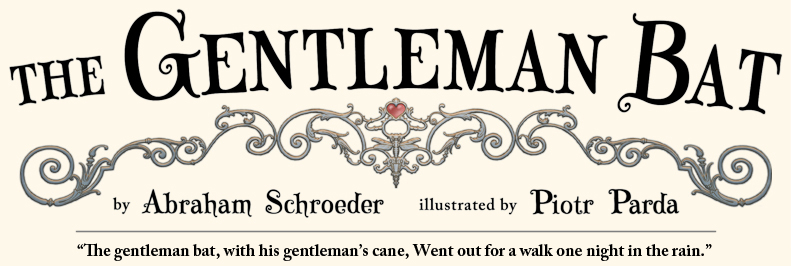
|
The light fixture above the gentleman bat's front door was modeled after a spectacular 1930's French iron lantern in the collection of Le Secq des Tournelles Ironwork Museum in Rouen, Normandy, France.
Click here to see the lantern.
(The URL and page title for the lantern have changed several times in a couple of years, so if the link results in a page not found, please try keywords "bat" or "lantern" in the museum's search bar.)
|

|
This came from an old sketch of Abraham's. When Piotr painted it into Batford, he added the delicious bugs, to better appeal to bats' tastes. The name is a nod to the publisher's daughter.
To learn more about what bats eat in real life, see the About Bats page on this website.
|


|
The oddly shaped lampshades in the shop window, looking like floating sea creatures,
are a wink to a 2004 installation, Medusa Phase by artist Lisa L. Gordon. In Batford, they would be stylish additions to any bat's home decor.
|

|
The wing on this blimp looks a lot like a bat wing.
How many other objects with structures similar to bat wings can you find in the book?
How about around your house or town?
|

|
It was only due to amazing sharpness of mind that Piotr didn't accidently draw a pair of human gloves on display in this store window. And if he had, there would have been a very strong chance that the human editors of the book would not have noticed until after it went to press.
Whew! That would have been embarrassing for everyone involved.
|

|
What in the world is that bat holding?
It's a hurdy gurdy.
What's a hurdy gurdy?
That requires more space than we have to explain.
Here is a good place to start your explorations.
|

|
The very fancy Art Nouveau storefront on the square (left side of this detail) is modeled after a landmark building in Harvard Square, Massachusetts, that Abraham has always really liked, so Piotr painted it into the book.
It has housed different businesses over the years, but was originally a shoe store, Coes & Young, designed in 1907 by architects Coolidge & Carlson, and built in 1913.
Many photographs of the beautiful woodwork can be found by searching online for the address, 1304 Harvard Avenue, Cambridge, MA.
|

|
You may have noticed that Batford is a port town.
Here are some sailor bats on shore leave. If you look very closely at their wings, you will see that they are tattooed.
What kinds of tattoo designs do you think bats would get?
Do you know anyone who has bat tattoos?
|

|
This bat has pierced ears.
Do you think that would interfere with echolocation?
|

|
Here is a shoe shine stand that also offers wing waxing.
It is important to keep your wings clean and in tip-top shape.
|

|
The little guy on the right in this detail is a cameo appearance of Piotr's friend John, who may often be found playing his pan flute.
The pet worm being walked by this lady bat is another fashionable trend in Batford.
How many other pet bugs can you find in the book?
|

|
There are not very many bats flying around Batford. Of course they can still fly, but most of them choose not to.
Bat's in real life, however, would find it difficult or impossible to walk upright on their hind legs.
For more about how real bats move and fly in our world, please see the About Bats page on this website.
How many other flying bats can you find in the book?
|

|
Here is another bat with a pet bug.
In this case, it is Piotr's mother and her dog ... errr ... beetle, Pipi.
"Cześć mamo!"
How many other pet bugs can you find in the book?
|

|
Batford is a busy little town, with a lot going on every night. Here we can see some of the many events and activities, and of course a flyer for a cave space for rent.
One poster advertises an opera production of Die Fledermaus. The title is German for "The Bat." Does the word sound a lot like "Flutter Mouse"? That's no coincidence!
The Weimar Puppets is a silly play on The Dresden Dolls, a band that was a big part of the local Boston music scene around the time Piotr and Abraham moved there.

The Dresden Dolls
(Photo by Lisa L. Gordon)
|

|
The original sketches for the band, shown below, had the bats seated with their instruments. They also looked a whole lot like bat versions of Boston-based band Walter Sickert & The Army of Broken Toys.
Piotr decided they would be more comfortable playng upside down, and lots of the details changed in the process of finishing the group.
Keep an ear out for more from this other bat band.


|

|
Who are those bats, coming to vist Batford?
In October of 2013, Abraham, his wife, and son, who now live in California, visited Piotr in Boston, and it happened to be in the middle of discussions about what townsfolk would be represented in the big crowd scene.
So if you were curious about what the author and his family look like, this painting is pretty much spot-on.
|

|
Who is this bat carrying drawing supplies?
Why, it is none other than Piotr Parda, the illustrator, holding pages in progress for The Gentleman Bat!
Maybe it is this very picture!
|

|
In an early draft of The Gentleman Bat, Abraham included a reference to a Magic Lantern Operator in the town square, that was inspired by the amazing vintage optical device collection of Richard Balzer.
When Piotr was making sketches for the book, after the magic lantern line had been cut from the text (...perhaps it will return in a sequel...), he painted the traveling storyteller, inventor, and showbat, as Piotr and Abraham's friend, E. Stephen, curator of the Empire S.N.A.F.U Restoration Project, who builds his own interactive optical and auditory devices, such as the fabulous one you see here.

Image courtesy E. Stephen Frederick
|

|
The lady bat's pose here looks surprisingly similar to that of actress Claudette Colbert in a rainy scene in the 1939 comedy movie Midnight.
Is that a strange coincidence, or does that just happen to be one of Piotr's favorite old movies?

|

|
These bat statues are posed in the manner of Three Wise Monkeys, Mizaru, Kikazaru, and Iwazaru, who see no evil, hear no evil, and speak no evil.
|

|
The Batford Science Center is modeled rougly after buildings at the Massachusetts Institute of Technology.
Do you see a pterodactyl hanging in the window?
|

|
This boat, found in the Batford harbor, is in the style of a Chinese Junk, an ancient design that is still in use today.
The adjustable folding sail looks a little like a bat wing.
How many other objects with structures similar to bat wings can you find in the book?
How about around your house or town?
|

|
This odd little detail was specially requested by Abraham, and Piotr was willing to to humor him by painting a bat version.
It is based on a similarly odd little detail in the center panel of the Hieronymus Bosch painting, Temptation of Saint Anthony, in the collection of Museo Nacional de Arte Antiga, in Lisbon, Portugal.

Why would a bat, or any flying creature, need a ladder, when it could fly instead? It's very mysterious.
Perhaps a chimney sweep bat would do better with a ladder than trying to fly around in tight spaces.
|

|
The design for the carved teak handle of the gentleman bat's cane drew inspiration from a Chinese gong stand in Piotr's living room.

|

|
In Polish, gargoyles or rainspouts like this are called rzygacz, "pukers", from the word rzygać, which means to vomit.
|

|
This pose may remind you of another character who famously went out for a walk one night in the rain.
Here is Gene Kelly in the 1952 classic, Singin' in the Rain:

|


|
Piotr was looking for fine furniture to fit the gentleman bat's house, so he went to sketch at the Museum of Fine Arts, Boston, where he found these two pieces on display: a lovely secretary desk, and a very cool couch made in Maryland around 1820.
|

|
Piotr snuck some of Abraham's sculptures and other artwork into the bat's display case. When we have a chance, we may post pictures of the originals here. For now they will have to remain somewhat mysterious, but be sure to check out the next two entries below for some really exciting things!
|

|
The Isabella Stewart Gardner Museum in Boston is home to a spectacular collection of beautiful art in a unique setting. Unfortunately, in 1990, thirteen important and valuable artworks were stolen from the museum in a mysterious heist that has baffled detectives for decades.
It's hard to see, but we think a couple of the paintings on the bat's wall look a little familiar. We're not trying to make light of the seriousness of the crime, but could not help noticing the resemblance.
Learn more about the stolen artworks here and decide whether or not you think the Gentleman Bat is a suspect here:
http://www.gardnermuseum.org/resources/theft
|

|
This is the print that started it all!
Sometime around 2005 or 2006, Abraham was working at the Museum of Fine Arts, Boston, cataloging the museum’s spectacular collection of Japanese prints, and found among them an 1880’s woodblock print of bats, by Tsukioka Yoshitoshi, which became the seed of inspiration that grew into The Gentleman Bat.
Click here to see the original print on the MFA website!
Copies of the print occasionally come up for sale, and if anyone out there happens to notice one, please let Abraham know immediately. He'd love to buy a copy if it is selling for a price he can afford, and he narrowly missed a few over the years. (Many thanks in advance!)
|

|
This elegant iron staircase is a bat-sized version of one in the collection of the Gustave Moreau Museum in Paris, France. You can find more information and images by searching online for "Gustave Moreau Staircase."
|

|
This frightful face is a wooden mask from Bali, depicting Barong, who is a fierce protector deity.
|

|
This is another nod to the Museum of Fine Arts, Boston, a slightly modified version of a large Edo period Japanese vase, one of a pair that was featured in an 1882 painting by John Singer Sargent. Instead of birds, this one features bugs, which are more to a bat's taste.
|

|
Piotr came up with this mechanism for closing the curtains, and then he and Abraham spent a lot of time sorting out where the weights and pulleys would go to make it work.
If you would like to install your own, please contact the Batford Curtain Shop on Main Street, who can customize the plans for your needs.
It is not something you can see in the illustration, but the ball at the end of the curtain pull is a small brass Ganesha. The Gentleman Bat collects things from all over the world to decorate his home.

|

|
Maybe this is an illustrated atlas of entomology.
Or maybe it is a cook book.
|
|
|
Piotr and Abraham had lots of fun hiding details and jokes throughout the book, and there are many more that are not explained here. It is fun to leave a few mysteries in artwork for viewers to puzzle out for themselves.
Have fun looking closely at the pictures while you read, and maybe check back here in a while to see if we have revealed any more secrets!
|
























 thegentlemanbat.com.
thegentlemanbat.com.


























